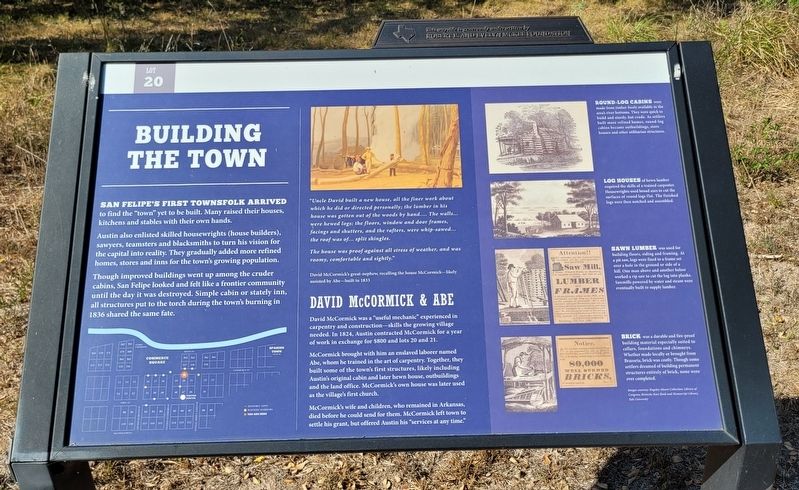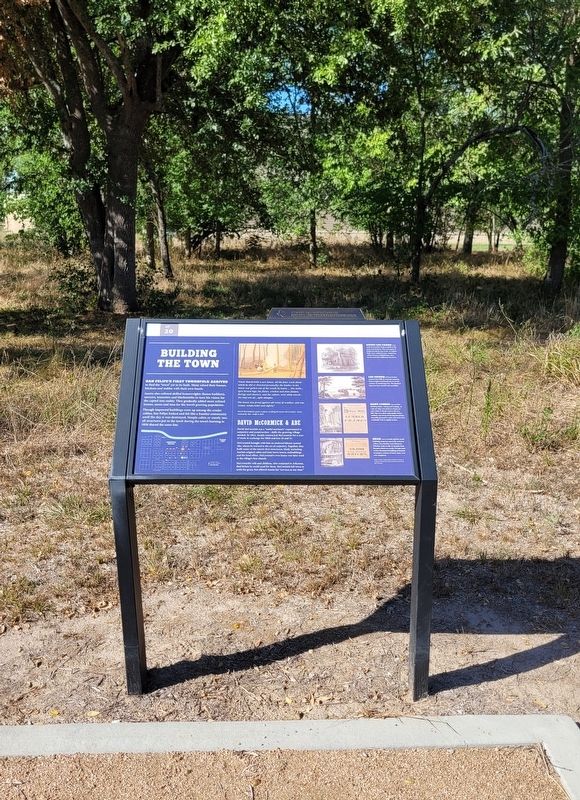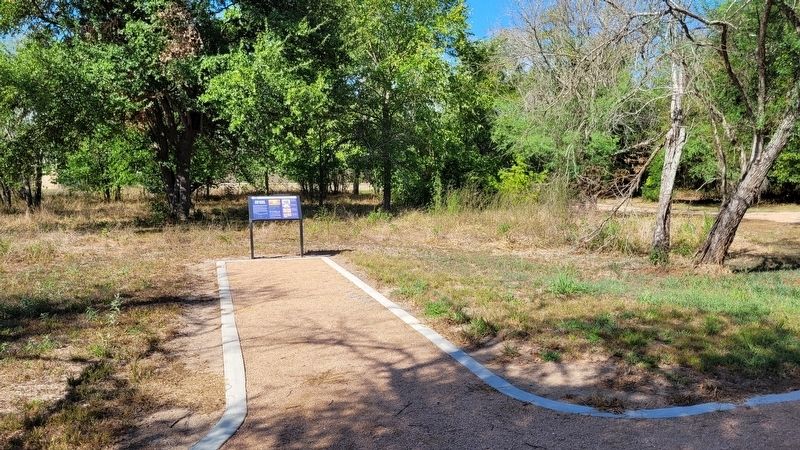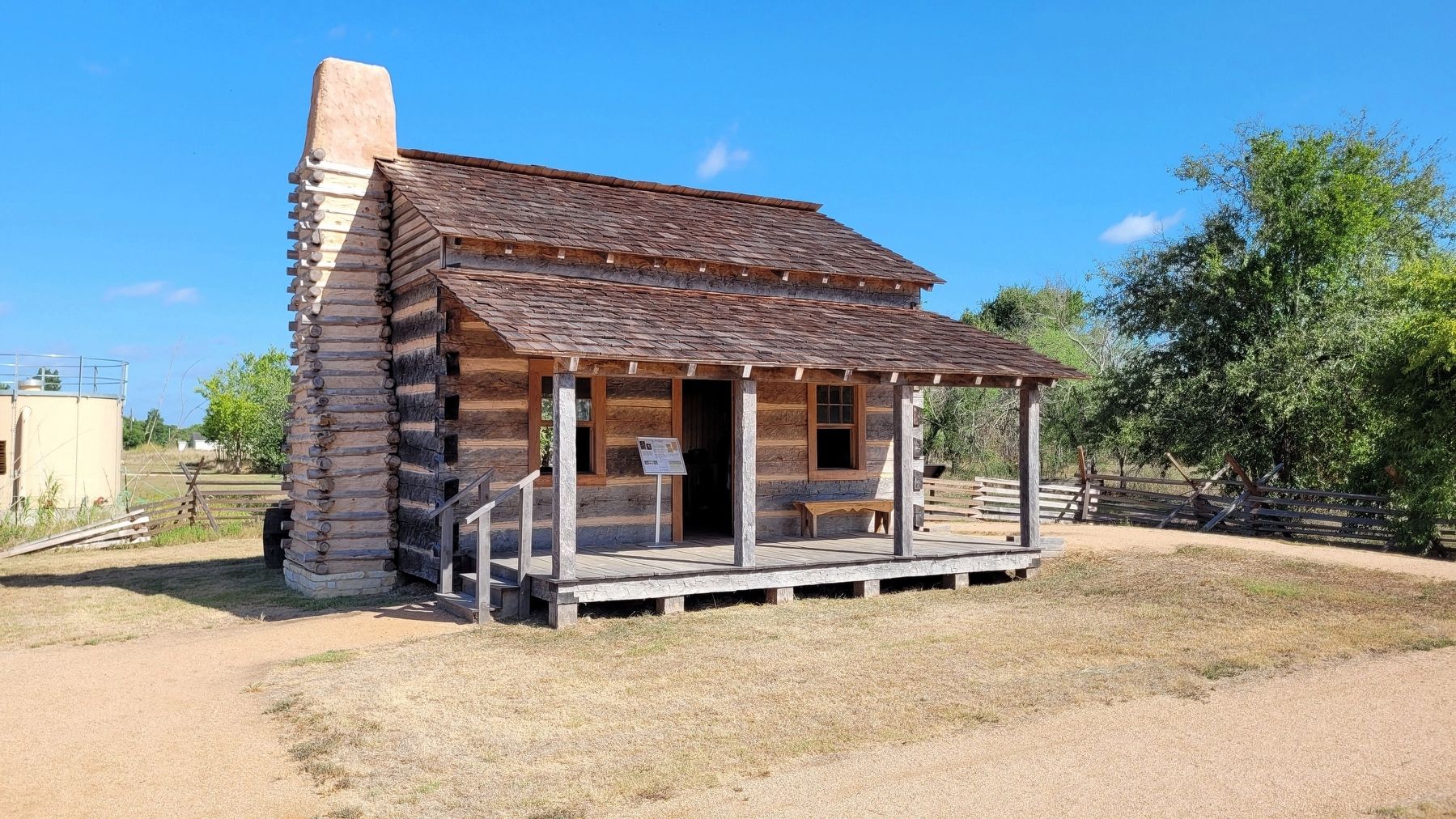San Felipe in Austin County, Texas — The American South (West South Central)
Building the Town
Lot 20
San Felipe's First Townsfolk Arrived to find the "town" yet to be built. Many raised their houses, kitchens and stables with their own hands.
Austin also enlisted skilled housewrights (house builders), sawyers, teamsters and blacksmiths to turn his vision for the capital into reality. They gradually added more refined homes, stores and inns for the town's growing population.
Though improved buildings went up among the cruder cabins, San Felipe looked and felt like a frontier community until the day it was destroyed. Simple cabin or stately inn, all structures put to the torch during the town's burning in 1836 shared the same fate.
"Uncle David built a new house, all the finer work about which he did or directed personally; the lumber in his house was gotten out of the woods by hand.... The walls... were hewed logs; the floors, window and door frames, facings and shutters, and the rafters, were whip-sawed... the roof was of... split shingles.
The house was proof against all stress of weather, and was roomy, comfortable and sightly."
David McCormick's great-nephew, recalling the house McCormick-likely assisted by Abe - built in 1833
David McCormick & Abe
David McCormick was a "useful mechanic" experienced in carpentry and construction-skills the growing village needed. In 1824, Austin contracted McCormick for a year of work in exchange for $800 and lots 20 and 21.
McCormick brought with him an enslaved laborer named Abe, whom he trained in the art of carpentry. Together, they built some of the town's first structures, likely including Austin's original cabin and later hewn house, outbuildings and the land office. McCormick's own house was later used as the village's first church.
McCormick's wife and children, who remained in Arkansas, died before he could send for them. McCormick left town to settle his grant, but offered Austin his "services at any time."
Round-Log Cabins were made from timber freely available in the area's river bottoms. They were quick to build and sturdy, but crude. As settlers built more refined homes, round-log cabins became outbuildings, store houses and other utilitarian structures.
Log Houses of hewn lumber required the skills of a trained carpenter. Housewrights used broad axes to cut the surfaces of round logs flat. The finished logs were then notched and assembled.
Sawn Lumber was used for building floors, siding and framing. At a pit saw, logs were fixed to a frame set over a hole in the ground or side of a hill. One man above and another below worked a rip saw to cut the log into planks. Sawmills powered by water and steam were eventually built to supply lumber.
Brick was a durable and fire-proof building material especially suited to cellars, foundations and chimneys. Whether made locally or brought from Brazoria, brick was costly. Though some settlers dreamed of building permanent structures entirely of brick, none were ever completed.
Images Courtesy: Rugeley-Moore Collection; Library of Congress; Beinecke Rare Book and Manscript Library; Yale University
Sponsor Plaque on top
This wayside is generosity underwritten by
Robert E. and Evelyn McKee Foundation
Erected by San Felipe de Austin State Historic Site.
Topics. This historical marker is listed in these topic lists: African Americans • Industry & Commerce • Settlements & Settlers • War, Texas Independence. A significant historical year for this entry is 1836.
Location. 29° 48.369′ N, 96° 5.746′ W. Marker is in San Felipe, Texas, in Austin County. Marker can be reached from the intersection of 2nd Street and Farm to Market Road 1458. The marker is located in the northeastern section of the San Felipe de Austin State Historic Site along the pathway. Touch for map. Marker is at or near this postal address: 220 2nd Street, San Felipe TX 77473, United States of America. Touch for directions.
Other nearby markers. At least 8 other markers are within walking
distance of this marker. A Home on Commerce Square (a few steps from this marker); Bottomland Farms (within shouting distance of this marker); Founding the Town (within shouting distance of this marker); Spanish Town (within shouting distance of this marker); Governing the Town (within shouting distance of this marker); Rio Brazos (about 300 feet away, measured in a direct line); Clopper Store (about 400 feet away); Burning of the Town (about 500 feet away). Touch for a list and map of all markers in San Felipe.
More about this marker. The marker is located on the grounds of the San Felipe de Austin Historic Site. There is a small fee to access the historic site and markers.
Also see . . .
1. San Felipe de Austin History. Texas Historical Commission
San Felipe de Austin was founded in 1824 by Stephen F. Austin as the unofficial capital of his colony. It became the first urban center in the Austin colony, which stretched northward from the Gulf of Mexico as far as the Old San Antonio Road and extended from the Lavaca River in the west to the San Jacinto River in the east. By October 1823, after briefly considering a location on the lower Colorado River, Austin decided to establish his capital on the Brazos River. The site chosen was on a high, easily defensible bluff overlooking broad, fertile bottomlands. The location offered a number of advantages, including a central location and sources of fresh water independent of the Brazos.(Submitted on September 18, 2022, by James Hulse of Medina, Texas.)
2. McCormick, David (1793–1836). Texas State Historical Association
David McCormick, one of Stephen F. Austin's Old Three Hundred colonists, the son of Andrew and Catherine (Adams) McCormick, was born in 1793. He moved to Texas from Hempstead County, Arkansas, in 1821. His wife and two children died in Arkansas while he was in Texas selecting land. On December 20, 1823, he voted in the election that chose Sylvanus Castleman alcalde for 1824. McCormick was among those who contributed a total of 630 bushels of corn in 1823 to pay the expenses of Erasmo Seguín, who was serving as Texas representative to the Mexican congress.(Submitted on September 18, 2022, by James Hulse of Medina, Texas.)
Credits. This page was last revised on March 6, 2024. It was originally submitted on September 18, 2022, by James Hulse of Medina, Texas. This page has been viewed 79 times since then and 10 times this year. Photos: 1, 2, 3, 4. submitted on September 18, 2022, by James Hulse of Medina, Texas.



